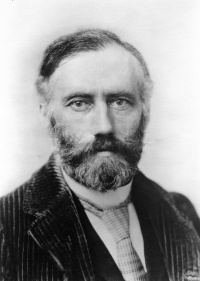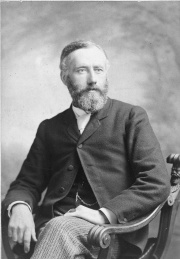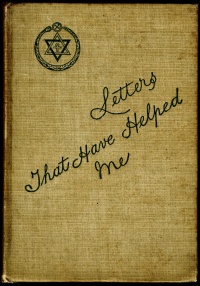William Quan Judge: Difference between revisions
No edit summary |
|||
| Line 13: | Line 13: | ||
[[File:WQ Judge in chair.jpg|180px|right|thumb|William Quan Judge]] | [[File:WQ Judge in chair.jpg|180px|right|thumb|William Quan Judge]] | ||
[[File:Letters That Have Helped Me.jpg|right|200px|thumb|''Letters That Have Helped Me'', 4th edition, 1891]] | [[File:Letters That Have Helped Me.jpg|right|200px|thumb|''Letters That Have Helped Me'', 4th edition, 1891]] | ||
== | == Personal life == | ||
== Legal and business career == | |||
== Legal career == | |||
After his schooling was completed, young Judge sought work in the legal profession. | After his schooling was completed, young Judge sought work in the legal profession. | ||
| Line 36: | Line 34: | ||
Judge became a frequent visitor at H.P.B.'s apartment, at 46 Irving Place, New York, where the founding of the Theosophical Society was soon to take place.<ref>Boris de Zirkoff, 473.</ref> | Judge became a frequent visitor at H.P.B.'s apartment, at 46 Irving Place, New York, where the founding of the Theosophical Society was soon to take place.<ref>Boris de Zirkoff, 473.</ref> | ||
</blockquote> | |||
His younger brother [[John H. Judge]] was also involved with H.P.B., assisting her in preparing the manuscript of | His younger brother [[John H. Judge]] was also involved with H.P.B., assisting her in preparing the manuscript of | ||
Revision as of 17:01, 3 May 2020
UNDER CONSTRUCTION
UNDER CONSTRUCTION
William Quan Judge was one of the principal Founders of the Theosophical Society in 1875. He provided superb leadership to the American Section until his untimely death in 1896, but left a body of writings that are among the clearest explications of the principles of Theosophy. See Judge writings.
According to Josephine Ransom,
WILLIAM QUAN JUDGE, was born in Dublin, 1851. He was brought up a Methodist, but early showed strong occult tendencies. The family migrated to New York, 1864. Judge became a naturalized American citizen at 21. He worked as a clerk at an early age as he had to be self-supporting. he married in 1874, and had one daughter who died of diphtheria, 1876. At the time of the formation of The Society he was a law clerk in the office of the U.S. Attorney for the S. District of New York. He was later admitted to the Bar, and made a speciality of Commercial Law. He was modest, unassuming, eager for occult instruction and ready to work. Though at first H.P.B. objected to Judge becoming a Councillor, yet he won her friendly regard and kept it. He developed leadership, and became one of the most important figures in The Society. Then difficulties arose, and he led the secession of the majority of American Lodges, 1895. He passed away 1896.[1]
Personal life
Legal and business career
After his schooling was completed, young Judge sought work in the legal profession.
He eventually became a clerk in the Law Office of George P. Andrews, who later became Judge of the Supreme Court of New York... On coming of age, William became a naturalized American citizen in April, 1872, and was admitted to the State Bar of New York one month later. His industry, natural shrewdness and inflexible persistence commended him to his clients and he became, as time went on, a specialist in Commercial Law.[2]
By the autumn of 1874, when he first met H. P. Blavatsky, he was employed in the law office of E. Delafield Smith, U S. Attorney for the Southern District of New York. He represented Madame Blavatsky in her divorce from Michael C. Betanelly, and the divorce was granted on May 25, 1878.
In 1884, after returning to New York after his visit to the Theosophical Society's international headquarters at Adyar, Madras, India, "Judge found his financial prospects greatly improved. He joined the law firm win which Olcott's brother worked."[3]
Meeting Olcott and Blavatsky
Mr. Judge knew Colonel Henry Steel Olcott from the legal community in New York, where they both worked.
After reading Col. Olcott's articles in the New York Daily Graphic (published in March, 1875, as a work entitled People from the Other World) outlinging his experiences as the Eddy homestead at Chittenden, Vt., where some weird Spiritualistic séances were being held, he wrote to the Colonel asking for an introduction to Madame Blavatsky. Eventually the desired invitation came, and resulted in an association that was to last throughout their lives.
Judge became a frequent visitor at H.P.B.'s apartment, at 46 Irving Place, New York, where the founding of the Theosophical Society was soon to take place.[4]
His younger brother John H. Judge was also involved with H.P.B., assisting her in preparing the manuscript of Isis Unveiled for publication. William Quan Judge's wife Ella, however, was actively opposed to his engagement in Theosophical interests.
Theosophical work
Founding of the Theosophical Society
Early years as Vice President
1884 work in Europe
1884 visit to Adyar
Formation of American Section
In 1886, Judge proposed to Olcott and Blavatsky that an American Section should be formed. With their approval, he took on the new role of permanent General Secretary. He began publication of his magazine The Path, and wrote many articles to fill the pages.
The Section was greatly invigorated by its first convention, held on October 30, 1886 in the home of Dr. J. D. Buck in Cincinnati.
Expansion of Theosophical literature
1893 World's Parliament of Religions
Judge, as Vice President, headed a delegation of Theosophists at the World's Parliament of Religions in Chicago. Annie Besant and Professor G. N. Chakravarti accompanied him by train from New York, stopping at the Cincinnati Theosophical Society on September 9 to dedicate the lodge's new Theosophical Hall. They were joined in Chicago by other official representatives of the Society, including the Anagarika Dharmapala, Miss F. Henrietta Müller, and Mrs. Isabel Cooper-Oakley. A Theosophical Congress was held within the greater Parliament on September 15-17. The six delegates spoke to packed halls, supplemented by Theosophists Dr. Jerome A. Anderson, Claude Falls Wright, Mrs. Mercie M. Thirds, Dr. J. D. Buck, and George E. Wright. Newspaper coverage of the event praised the Theosophical Congress and its speakers lavishly, and the event was considered to be a complete success in promoting the tenets of Theosophy and the understanding of world religions.
Writings
Mr. Judge was a proficient writer and editor. His works are among the clearest explications of the principles of Theosophy. See Judge writings.
Correspondence
Mr. Judge conducted an extensive correspondence with Madame Blavatsky, Colonel Olcott, A. P. Sinnett, Josephine Cables, and other members of the Theosophical Society. Many were published in The Theosophist and The Path, in these compilations:
- Judge, William Quan, and Julia Keightley. Letters That Have Helped Me . Available at Theosophical University Press Online. These letters form a conversation between "Jasper Niemand," the pseudonym used by Julia Keightley, and "Z," representing Judge. See also these sources: Theosophy World, ULT, London, and Hathitrust.
- Mavalankar, Damodar K. Damodar, The Writings of a Hindu Chela compiled by Sven Eek. See also Biographical notes. Originally published in 1940 by Theosophical University Press, Point Loma, California. Six letters written to Judge by Damodar K. Mavalankar are reproduced from originals held in the Archives of the Theosophical Society based in Pasadena, California.
- Bowen, Patrick D. and K. Paul Johnson, eds. Letters to the Sage: Selected Correspondence of Thomas Moore Johnson Volume One: The Esotericists. Forest Grove, OR: The Typhon Press, 2016.
Death
Mr. Judge had been ill for some time, from lingering results of Chagas disease (often erroneously referred to as Chagres fever) contracted in Venezuela. His friend Ernest Temple Hargrove wrote to Dr. J. D. Buck early in 1896:
I think that Judge is ten per cent weaker than when you saw him. Today and last night his cough seemed rather better; the mucus came away more easily. But he can hardly walk. He asked me last night "use your intuition. How long do you think this can last?" I said "If it goes on not more than a week." That was in reference to a crisis through which both he and I thought he was passing. For the drop was very sudden--ten percent in a day--yesterday. I do not know what caused it; nor does he. There is nothing else at all now. He gets more sleep now during the day.
Truly, even to the lay eye, it is a case full of contradictions, and it is impossible to take any view or form any opinion that is not flatly denied by facts within the next 24 hours. I should not be surprised at anything; not even at seeing him improved 20 per cent in a day.[5]
Mr. Judge passed away on March 21, 1896 in New York.
Tributes and honors
The William Q. Judge Library is at the headquarters of the Temple of the People in Halcyon, California. B. P. Wadia established the William Quan Judge Cosmopolitan Home for university students at the Indian Institute of World Culture. It was a hostel based Theosophical principles.[6]
Many colleagues have written of Judge:
Katherine Hillard
Some little time elapsed before I learned to recognize, under that quiet and rather insignificant exterior, the wisdom, the practical common sense, the humor and the independence of the man. Day by day I learned to know him better, and to trust him more...
To the mystical element in the personality of Mr. Judge was united the shrewdness of the practical lawyer, the organizing faculty of a great leader, and that admirable common sense which is so uncommon a thing with enthusiasts. . . . And blended with the undaunted courage, the keen insight, the endless patience, that made his personality so powerful, were the warm affections, the ready wit, the almost boyish gaiety that made it so lovable.[7]
Obituary in Mercury
Mercury, the journal of the American Section of the Adyar Society published this gracious and conciliatory obituary:
On 21st of March William Q. Judge quitted this sphere of activity. The news saddened all for every heart kept a shrine sacred to the well-beloved co-worker of H.P.B. We remember only his virtues, which were many, his talents which were great, and we know that the good he did for the many years he labored as the Vice-President of the T. S. and Secretary of the American Section will bless his name for all time. All honor to his memory.[8]
Additional resources
Articles
- Anonymous. "William Quan Judge". From Eclectic Theosophical History, June 2006.
- Anonymous. "William Quan Judge." The Canadian Theosophist 20:2 (April 15, 1939), 35.
- Van Mater, Kirby. "William Quan Judge: A Biographical Sketch." williamquanjudge.net. Reprinted from Sunrise Magazine, April/May 1996.
- William Quan Judge page on Theosophy.net.
- Articles by William Quan Judge at Katinkahesselink.net.
- Anonymous. "William Quan Judge." The Canadian Theosophist 20:2 (April 15, 1939), 35.
Notes
- ↑ Josephine Ransom, A Short History of the Theosophical Society (Adyar, India: Theosophical Publishing House, 1938), 112.
- ↑ Boris de Zirkoff, "Judge, William Quan" H. P. Blavatsky Collected Writings Volume I (Wheaton, Illinois: Theosophical Press, 1966), 472.
- ↑ Boris de Zirkoff, 473.
- ↑ Boris de Zirkoff, 473.
- ↑ E. T. Hargrove letter to J. D. Buck. Dated "Thursday, 1896." Cincinnati Theosophical Society Papers. Records Series 20.02.01. Theosophical Society in America Archives.
- ↑ W. Dallas TenBroeck, "Biographical Notes on Sri B.P. Wadia" Keeping the Link Unbroken (Theosophical Research Monographs, 2004), 120.
- ↑ Katherine Hillard, "Why I Became a Theosophist" Theosophical Quarterly (July, 1909), 59-61. Available at Blavatsky Archives.
- ↑ J. Helen Smith, "Obituary" Mercury 2.9 (April, 1896), 276.


